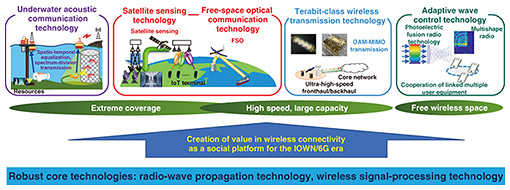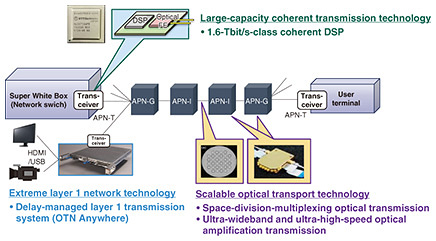 |
|||||||||||||||||
|
|
|||||||||||||||||
|
Feature Articles: High-capacity, Low-delay Transmission Technologies Utilizing Optical, Radio, and Acoustic Waves for IOWN/6G Vol. 22, No. 7, pp. 19–25, July 2024. https://doi.org/10.53829/ntr202407fa1 Achieving IOWN/6G and Creating New Value with World-leading TechnologiesAbstractNTT Network Innovation Laboratories (NIL) is committed to the practical application of IOWN (the Innovative Optical and Wireless Network) with its world-leading technological capabilities. NIL also conducts research and development with the mission of enhancing the competitiveness of the NTT Group by developing the world’s first and most advanced technologies to bring about social change and create new value. This article provides an overview of the technologies being researched and developed by NIL. Keywords: All-Photonics Network (APN), optical transmission technology, wireless transmission technology 1. IntroductionNTT Network Innovation Laboratories (NIL) is engaged in research and development (R&D) with the aim of establishing communication technologies that enable long-distance, high-speed, and large-capacity information transmission over a wide range of areas, including optical fibers, air, underwater, and other communication media, using physical waves in various frequency bands such as optical, radio, and acoustic waves. Figure 1 shows the areas of NIL°«s R&D efforts. While focusing on optical communications in optical fibers, radio communications in air and space, and acoustic communications in water, we are also developing communication technologies in the boundary region between radio waves and light, such as free-space optical communications (FSO).
NIL is promoting the R&D of the All-Photonics Network (APN) to implement the Innovative Optical and Wireless Network (IOWN) promoted by NTT. The APN IOWN1.0 service was launched in March 2023, in which users can exclusively use optical wavelength end-to-end, providing high-speed, high-capacity, low-latency, and low-jitter networks. For this APN IOWN1.0 service, we developed an optical transport network (OTN) transmission system called OTN Anywhere that embodies a delay-managed network that can freely control communication delays. NIL is conducting R&D to improve the performance and convenience of IOWN in the directions shown in Fig. 2. Toward IOWN2.0, which is expected to be implemented in 2025 or later, we are developing OTN Anywhere to accommodate a wider variety of client signals and manage delays at a finer granularity. We are also engaged in R&D on elemental technologies that contribute to improving the usability of IOWN, such as the development of a digital signal processor (DSP) that enables large-capacity transmission of 1.6-Tbit/s class by using digital coherent optical transmission technology, automatic optical path provisioning (AOPP) and remote control technology, a secure optical transport network that provides secure network services using post-quantum cryptography (PQC), and an IOWN infrastructure processing unit (IPU) board that achieves ultra-low and deterministic delay data transmission.
Toward IOWN3.0, which we aim to implement in 2029 or later, we are developing elemental technologies for further increasing the capacity and distance of the IOWN APN, such as the development of space-division-multiplexing technology and scalable optical transport technology to achieve petabit-class transmission throughput in the APN, terabit-class wireless transmission technology for wireless xHaul supporting IOWN/6th-generation mobile communication system (6G), and underwater acoustic communication technology to achieve large capacity, multiplexing, and security. Toward IOWN4.0, which we aim to implement in the 2030s, we are engaged in R&D to develop an information and communication infrastructure that provides new value distinct from that of existing services, such as R&D of a scalable quantum network using quantum repeaters and adaptive wave control technology that forms a free wireless space with high precision. In the following sections, we introduce the cutting-edge technologies we are developing, which can be categorized as frontier communication technologies, wave propagation technologies, and optical transport innovation technologies. 2. Frontier communication technologiesThe outline of the frontier communication technologies is shown in Fig. 3. To create mission-critical services, such as smart cities, medicine, and finance, by using widely distributed computing resources, we will develop transport and control technologies and quantum communications that transmit qubits.
2.1 High-speed data/media transport (IOWN IPU board)We established technology to transmit data and media with ultra-low and deterministic delay on the IOWN APN to provide services with high real-time performance such as smart cities, medical care, and finance [1]. In high-speed data transport, we will implement the IOWN IPU board to enable data transmission with ultra-low and deterministic delay between memories as well as software development kit (SDK) to enable applications to determine the transmission-processing delay through delay measurement with high-precision time synchronization. High-speed media transport enables ultra-low-latency media transmission such as uncompressed video and three-dimensional video. 2.2 Automatic optical path setting and remote control (AOPP)To achieve datacenter exchange (DCX) that dynamically connects datacenters in response to user requests by using the IOWN APN, automatic provisioning that sets optical wavelength paths on demand will be achieved. This is achieved by setting the parameters of optical wavelength paths on the basis of the result of the transmission-path estimation between multi-user bases under different conditions such as device vendors and propagation characteristics on demand [2]. By implementing the remote control agent function on optical transponders installed at user sites, it will be possible to set up the parameters of optical transceivers and monitor the status of the transceivers from telecommunication carrier facilities. By advancing the standardization of the monitoring and control interface, we aim to provide DCX services using open and multi-vender optical transponders. 2.3 Secure optical transportIn anticipation of future eavesdropping and tampering by using quantum computers, we are developing a technology to guarantee the safety of optical wavelength paths in the APN by means of PQC. To expand security functions in line with future advances in security and transmission technologies, this technology has a functional architecture that disaggregates key-exchange functions, key-management functions (software processing), and cryptographic functions (hardware processing) and achieves strong security (multifactor security) by synthesizing multiple keys with different reliability bases obtained using different key-exchange methods. 2.4 Radio-environment analysis and prediction technologyUsing a variety of physical-space information, including non-communication sensor devices such as cameras and sensors, we are developing technologies to predict the future communication quality of a few seconds ahead and always ensure broadband and low-latency radio communications. This will promote the effective use of frequency resources in high-frequency bands, such as millimeter waves, and be applied to mission-critical use cases such as robot control, which have traditionally been difficult in the radio environment. 2.5 Quantum communication technologyTo network many quantum computers and exponentially improve computing power, we are developing quantum communication technology that transmits quantum bits handled by quantum computers. We aim to establish photon communication and quantum entanglement communication technologies to achieve stable long-distance and high-speed communications, and quantum node configuration and management technology to implement quantum networks. 3. Wave propagation technologiesWe are developing wave propagation technologies to create value in wireless connectivity as a social platform for the IOWN/6G era (Fig. 4). In underwater acoustic communication technology and satellite sensing technology, we are aiming for extreme coverage expansion to expand communication areas into the ocean, space, and sky in addition to terrestrial communications. We are also investigating high-speed, large-capacity transmission that improves communication speed through FSO technology and terabit-class wireless transmission technology. We are also investigating adaptive wave control technology as the ultimate wireless communications that can freely control the communication area and form a highly accurate wireless space.
3.1 Underwater acoustic communication technologyExpectations to improve operational efficiency by using communications in industrial fields, such as seabed resource development, port facility construction, and marine facility inspection, are increasing due to the expansion of extreme coverage into the ocean, which has been an unexplored area as a mobile communication system. Through the establishment of spatio-temporal equalization technology and environmental-noise-resistance-improvement technology for achieving high-speed, long-distance, and stabile underwater acoustic communications, high-speed transmission of 1-Mbit/s class was achieved, and the world°«s first wireless remotely operated vehicle equipped with this technology was demonstrated in an open experiment [3]. In cooperation with various partners in the industrial field, we are studying the applicability of technology to more specific operations and conducting various R&D projects such as on underwater acoustic positioning and wide-area communication networks. 3.2 Satellite sensing technologyWe are developing the basic technology of a satellite sensing platform that collects Internet of Things (IoT) data using general low-power wide-area terminals that are widely used on the ground without using satellite-specific equipment or frequencies [4]. We aim for sensing on a global scale by using extreme-coverage communication platforms that cannot be covered by terrestrial networks, such as in mountainous areas and oceans. 3.3 FSO technologyWe are engaged in research on spatial optical communication technologies with the aim of establishing new communication infrastructure technologies that enable the provision of ultra-high-speed wireless links to locations and mobile devices where optical fibers are difficult to install. We are aiming for ultra-high-speed, large-capacity transmission by high-efficiency fiber coupling using wavefront compensation technology for atmospheric turbulence caused by atmospheric propagation and to apply it to rapid temporary network recovery in the event of a disaster. 3.4 Terabit-class wireless transmission technologyThe fronthaul and backhaul in the IOWN/6G era are expected to require terabit-class wireless transmission technology. To achieve this, we are investigating high-speed, large-capacity wireless transmission by increasing the bandwidth and number of spatial multiplexes. We have demonstrated the world°«s first high-capacity wireless transmission of 1.4 Tbit/s by orbital angular momentum (OAM) multiplexed transmission using ultra-high bandwidth in the sub-terahertz band [5]. We aim to demonstrate long-distance transmission over 100 m, assuming various applications in the real world. 3.5 Adaptive wave control technologyIn the wireless system of IOWN/6G, it is assumed that a wide variety of devices will be connected wirelessly, which will increase interference between users and power loss due to utilization of high frequency bands. As elemental technologies contributing to the resolution of these issues, we are developing multi-shape wave control technology that bends and straightens the propagation area on the basis of wave-control, terminal-coordinated user-centric radio access network technology that adaptively forms a wireless space by cooperating with terminals, and optical matrix wireless beamforming technology that uses photoelectric fusion to enable wireless beamforming in large-scale array antennas with circuit saving. 4. Optical transport innovation technologiesToward the implementation of the APN, which forms the basis of IOWN, we are engaged in R&D on optical transport innovation technologies that will improve the added value and increase the capacity of optical networks (Fig. 5). To advance APN services and expand use cases, we are promoting R&D of extreme layer 1 network technologies that bring new value to users and operators. We are also developing high-capacity coherent transmission technology to achieve high-capacity and low-power optical paths and developing scalable optical transport infrastructure technologies that achieve Pbit/s-class transmission throughput per link to efficiently accommodate a huge amount of future communication traffic.
4.1 Extreme layer 1 network technology (OTN Anywhere)By creating elemental technologies that bring value to users and operators through layer 1 networking, we aim to contribute to the advancement of APN services and expansion of use cases. We are conducting R&D on a delay-managed transmission system (OTN Anywhere) that measures and controls network delays with high precision and layer 1 hit-less switching technology that changes the network configuration without bit loss of communication data to provide new value-added functions for high-capacity, low-latency layer 1 communication paths and bring about changes in user experience. We are expanding the use cases through demonstration experiments such as remote surgery using these technologies and fair eSports remote competition. 4.2 High-capacity coherent transmission technology (coherent DSP)We are aiming to establish a digital coherent optical transmission technology that will enable high-speed large-capacity optical transmission over 1 Tbit/s per wavelength, which is essential for APN construction, to extend transmission distance and reduce power consumption. We are researching and developing technologies for providing optimal optical paths by flexibly changing the transmission scheme and compensation processing in rapidly expanding application areas, which are applied not only to conventional long-distance transmission for carriers but also to short-distance transmission such as datacenter interconnect. We are also developing a digital signal processing circuit (coherent DSP) for 1.6-Tbit/s-class optical communications, which is a key device for achieving high-capacity coherent transmission at low power. 4.3 Scalable optical transport technologyTo construct Pbit/s-class optical networks that can accommodate communication traffic, which will rapidly increase in the future due to the development of high-speed mobile access and the spread of artificial intelligence services, we aim to establish a scalable optical network technology of 1-Pbit/s-class capacity per link by developing innovative ultra-high-capacity transmission technologies and optical signal processing technologies. As elemental technologies to achieve large-capacity transmission, we are engaged in R&D on basic technologies such as large-capacity space-division-multiplexing transmission technology [6, 7] using core and mode multiplexing and wide-band optical-amplification and wavelength-band conversion technologies [8] using wide-band parametric optical amplification. 5. ConclusionWe outlined the efforts of NIL on cutting-edge technologies toward IOWN/6G. Toward the deployment of IOWN/6G scheduled for 2030, we will continue to collaborate with business partners and specialists in a variety of industries to achieve early establishment of various elemental technologies. References
|
|||||||||||||||||


















